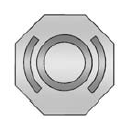Chevrolet Spark Owners Manual: Brake Fluid
 The brake/clutch master cylinder
The brake/clutch master cylinder
reservoir is filled with DOT 4 brake fluid as indicated on the reservoir cap. See
Engine Compartment Overview on page 10-7 for the location of the reservoir.
There are only two reasons why the brake fluid level in the reservoir might go down:
- The brake fluid level goes down because of normal brake lining wear. When new linings are installed, the fluid level goes back up.
- A fluid leak in the brake/clutch hydraulic system can also cause a low fluid level. Have the brake/ clutch hydraulic system fixed, since a leak means that sooner or later the brakes will not work well.
Do not top off the brake/clutch fluid.
Adding fluid does not correct a leak.
If fluid is added when the linings are worn, there will be too much fluid when new brake linings are installed. Add or remove fluid, as necessary, only when work is done on the brake/clutch hydraulic system.
Warning
If too much brake fluid is added, it can spill on the engine and burn, if the engine is hot enough. You or others could be burned, and the vehicle could be damaged.
Add brake fluid only when work is done on the brake/clutch hydraulic system.
Checking Brake Fluid
The brake/clutch fluid can be checked without taking off the cap by looking at the brake/clutch fluid reservoir.
The fluid level should be above MIN. If it is not, have the brake/ clutch hydraulic system checked to see if there is a leak.
After work is done on the brake/ clutch hydraulic system, make sure the level is above MIN but not over the MAX mark.
When the brake/clutch fluid falls to a low level, the brake warning light comes on. See Brake System Warning Light on page 5-15.
What to Add
Use only new DOT 4 brake fluid from a sealed container. It is recommended that the brake/clutch hydraulic system be flushed and refilled with new DOT 4 fluid at a regular maintenance service every two years. See Maintenance Schedule on page 11-3 and Recommended Fluids and Lubricants on page 11-12.
Always clean the brake/clutch fluid reservoir cap and the area around the cap before removing it. This helps keep dirt from entering the reservoir.
Warning
With the wrong kind of fluid in the brake/clutch hydraulic system, the brakes might not work well. This could cause a crash. Always use the proper brake/clutch fluid.
Caution
- Using the wrong fluid can badly damage brake/clutch hydraulic system parts. For example, just a few drops of mineral-based oil, such as engine oil, in the brake hydraulic system can damage brake hydraulic system parts so badly that they will have to be replaced. Do not let someone put in the wrong kind of fluid.
- If brake fluid is spilled on the vehicle's painted surfaces, the paint finish can be damaged. Be careful not to spill brake fluid on the vehicle. If you do, wash it off immediately.
 Brakes
Brakes
Disc brake pads have built-in wear indicators that make a high-pitched warning
sound when the brake pads are worn and new pads are needed.
The sound can come and go or be heard all the time when th ...
 Battery
Battery
The original equipment battery is maintenance free. Do not remove the cap and
do not add fluid.
Refer to the replacement number shown on the original battery label when a new
battery is needed. S ...
Other materials:
Engine Overheating
The vehicle has an indicator to warn of the engine overheating. See Engine Coolant
Temperature Warning Light on page 5-18.
If the decision is made not to lift the hood when this warning appears, get service
help right away. See Roadside Assistance Program on page 13-5.
If the decision is made ...
Tire Chains
Warning
Do not use tire chains. There is not enough clearance. Tire chains
used on a vehicle without the proper amount of clearance can cause damage to the
brakes, suspension, or other vehicle parts. The area damaged by the tire chains
could cause loss of control and a crash.
Use another typ ...
Delayed Locking
This feature delays the locking of the doors until five seconds after all doors
are closed.
When is pressed on the power door
lock switch while the door is open, a chime will sound three times indicating delayed
locking is active.
The doors will lock automatically five seconds after all doo ...
